There is an elevated scope in the field of health and wellbeing benefited for herbs and botanicals. One foremost reason is that they play a vital role in the natural safeguard against some disease. Diuretics are the class of drugs which are used to decrease the elevated blood pressure. These are the agents which are used mainly to increase the urine output and electrolyte excretion. It acts on different part of nephrons and help to increase urinary outflow. In olden days many herbal plants are used to treat different diseases there had been multiple research on the land plant, so focusing on the unique characters of the aquatic plant. This article gives information of aquatic plant role in diuresis.
Aquatic plant, diuretic activity, chemical constituents, mechanism of action..
Worldwide moves towards the natural remedies for treatment of various types of diseases by using the medicinal plants which are concealed in nature. Herbal plants are used by the distinct communities to treat different diseases.1Both terrestrial and aquatic plants have equal importance in medicine. There have been multiple researches on land plants, so nowadays the researchers are mainly focusing on the unique features of aquatic plants. These plants are hydrophytes present in aquatic environment. Aquatic plants are rich in biochemical constituents like sterols, alkaloids, saponins, flavonoids, dauricine, lotusine, pronuciferine, procyanidine, remerine, quercitine, hyperoside and astragalin. There are several aquatic plants which have been reported for their different pharmacological activities.2 Diseases like hypertension, edema, Kidney-stone are becoming common now a days, diuretic stand out as essential drugs for addressing these issues by increasing urinary output from the body. There has already been reported that aquatic plants are used for diuretic. This activity reviews the indication, actions and contraindication of aquatic plants. The aim of this article is to study and identify the importance of aquatic plants in diuretics. Pistia stratiotes, Nasturtium officinal, Nelumba nucifera, Marsilea quadrifolia, Nymphaea pubescens, Callitriche palustris, Typha angustifolia, Lemna minor, Spirodela polyrhiza, Ultricularia macrorhiza are the aquatic plants show significant diuretic activity.
Diuretic activity and mechanism of action of different aquatic plants
1. Pistia stratiotes Linn.
Pistia stratiotes Linn. is the aquatic plant obtained abundantly in ponds, river and streams with a different morphological characteristics, Leaves are oblong speculate with light green color on the upper side and whitish color on the underside. Roots are feathery and sag freely on water. Plant is rich in alkaloids, Glycosides, flavonoids and phytosterols, sterols, leaf and stem is rich in water, protein, carbohydrates and vitamin A and C. Leaf extract of this plant is used to treat leprosy, eczema, ulcer piles and syphilis and many more, the diuretic activity of Pistia stratiotes Linn. is studied in Lipchitz method by using Wistar albino rat. Ethanolic extract of Pistia stratiotes ability to block sugar absorption and it is also increase bulk of urine, regulate the body electrolyte. Result reveals that extract of Pistia stratiotes significantly shows diuretic activity. [3]
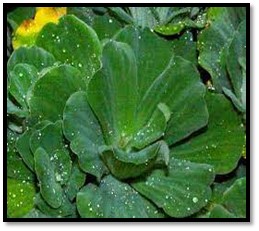
Fig no.1: Pistia striates Linn.
2. Nelumba nucifera
Nelumba nucifera is an aquatic plant which occupies a large space in the water bodies. Leaves of plants are large with two distinct morphological characteristics that are aerial and floating orbicular, Rhizomes are stout and yellowish in color with green fruits. Nelumba nucifera is called by different names in a various regions e.g. Indian lotus scared lotus and Chinese water lily. Plant extract is rich in dauricine, lotusine, pronuciferine, procyanidine, remerine, quercitine, hyperoside and astragalin. In an ancient medicine this plant is used for the treatment of skin disease, Leprosy, Vomiting, anthelmintic and diuretic activity. The rhizomes of Nelumba nucifera possess a diuretic activity it is studied in vivo by using albino rat. Ethanolic extract of Nelumba nucifera increase the urine output with significant excretion of Na+, Cl- and K+ and there is significant increase in natriuretic, chloruretic but shows less kaliuresis activity. [4]

Fig no.2 : Nelumba nucifera
3. Nasturtium officinale
Nasturtium officinale is an aquatic and semi-aquatic plant. Leaves sprout dark green and pinnate, while small, white flowers with four petals bloom in racemes. Plant produces a siliqua fruit packed with many reddish-brown seeds. Alkaloids, glycosides, saponins, folic acid, Isothiocyanate, polyphenols, vitamins, caretenoids and terpens are abundant in Nasturtium officinale. Across different languages, N. officinale acquires diverse identities known as peppery watercress, Brunnenkresse and Wasserkresse. It is potential as a natural remedy with powerful Antioxidant, anticancer, antibacterial, anti-inflammatory and cardio protective effects has been extensively investigated in pharmacological studies. Nasturtium officinale potentially used as diuretic drug, hydrophilic extract of plant shows decrease in urinary calcium oxalate concentration.[5]

Fig no.3: Nasturtium officinale
4. Marsilea quadrifolia
It is aquatic medicinal plant. This is typically grown on Irrigation channel of paddy field. Which is four part leaf floating on shallow water It is one type of weed which is growing on rice fields, small pools and ponds all over the world. This plant is widely distributed in North America, china, Japan, Afghanistan, china, Europe, Northern unite state. it can be used as food in south India. Which containing number of Phytoconstituents are saponins, steroids, Alkaloids, Carbohydrates, Flavonoids, Terpenoid, tannins M.quadrifolia belongs to the Family Marsilaceae. Another name of M.quadrifolia is water clover/four petaled. It is used to treat snake bite, cough, bronchitis, Diabetes, skin diseases, Diarrhea, Eye diseases and psychiatric diseases. It will increase urinary excretion from the body. This in turns causes removal of toxins, waste products and Excess water. Mainly the Fluid retention will be controlled. Decoction of M.quadrifolia is taken to treat Nephritis. This plant which reduces blood pressure and it is referred to taken for hypertension patients.[6]
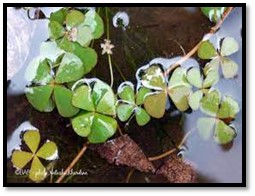
Fig no.4: Marsilea quadrifolia
5. Enhydra fluctuans Lour
Enhydra fluctuans Lour is an annual herbal plant which is spread in the banks of small streams found in tropical Asia (most abundantly in the region of Philippine, India, Srilankan, Burma) belonging to family Asteraceae. Such plants have fleshy stems approximately 30cm in length or maybe more, have roots down the nodes and are moderately hairy. Their leaves are stalkless and pointed at the tip 3-5cm long while the flowers are either white or greenish white and possess fruit. Thorough photochemical analysis of this plant has concluded that they contain alkaloids, saponins, flavonoids, triterpenoids, tannins, carbohydrates and glycosides as significant phytoconstituents. Their leaves are used as Anti-bilious and they are also having medicinal properties like antimicrobial, analgesic, ant diarrheal, antioxidant, anticancer, CNS depressant, iron chelating, hepatoprotective, gastroprotective and as an Anti-nephrolithiasis.7 Traditionally various tribes in Northeast India and Philippine people consume decoction of E. Fluctuans for the treatment of kidney stones and urinary problems (nephrolithiasis). Pharmacology studies have predicted that the aquas extract of this plant exhibits the mechanism in which they inhibit the formation of calcium oxalate crystallization and have effect on in vitro growth of calcium phosphate crystals which are present in people suffering from kidney stones thereby treat the illness of nephrolithiasis.[8]
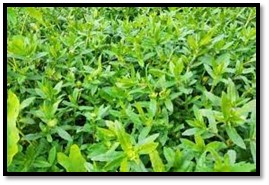
Fig no.5: Enhydra fluctuans Lour
6. Marsilea minuta
Marsilea minuta which have common names like water clover fern, green clover fern, dwarf four leaf clover is an aquatic herbaceous fern having slender rootstock, creeping, branched, leaves arranged in two rows, four leaflets, light dark in color, have wiry stems and the sporocarps are covered with brown hairs when they are young. Widely distributed in the muddy places, ditches, shallow pools and rice fields and are native to Bangladesh, Cambodia, China, Himalaya, India, Taiwan, Thailand and Vietnam etc. Studies have yielded alkaloids, saponins, phenolics, flavonoids, high protein content, monoterpenoid, diterpenoid and fatty acid compounds as the phytoconstituents. They own properties like; sweet taste, cooling nature, antioxidant, estrogenic, anti-H pylori, anti-skin aging and possess therapeutic effects such as diuretic, antiphlogistic and tranquilizer etc. From studies the researchers have explored the effect of M. minuta leaves extract and steak juice in preventing disturbances of kidney functions in male Wister rats with urolithiasis and the results showed that the leaf extract and stalk juice of this plant can prevent kidney function disturbance, urolithiasis, diuresis because they decrease in BUN and increase in Cr clearance.[9]

Fig no.6: Marsilea minuta
7. Rotula aquatica Lour.
Rotula aquatica Lour. is an aquatic plant commonly known as Pasanabheda in ayurveda and are widely distributed throughout India. This plant occurs as a small, branched shrub, then grows characteristically on rocks and tails over pebbles in stream beds. Studies have found that this plant consists of polyphenols, and tannins as the most important constituents which are therapeutically active as Diuretics, anti-urolithiasis, hypoglycemic, anti-inflammatory and antibacterial. Traditionally this plant is used in regulating the kidney and bladder stones, the root decoction are used for diuretic activity and aqueous root extract has activity on urolithiasis rats which indicated that the plant is effective in decreasing the urolithiasis, regeneration of renal tissues in male rats and have potential to cure urolithiasis.[10]
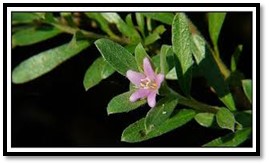
Fig no.7: Rotula aquatica Lour
8. Acorus calamus
Acorus Calamus is a semi-evergreen perennial hairless herb, can grow to two meters high and possesses a creeping rhizome. It contains various active constituents including phenyl propanoids, sesquiterpenes, monoterpenes, xanthone glycosides, flavones , lignans and steroids .It is utilized in the treatment of a variety of ailments such as cough , fever, bronchitis, inflammation, depression , tumors, hemorrhoids, skin diseases , numbness and general debility and it serves as a antidote for several types of poisoning .The Lipschitz method was utilized to evaluate the diuretic activity of the ethanolic extract (EEAC) of calamus , revealing that at doses of 250 and 500 mg/kg. EE did not induce a significant rise in urine volume. However, at a dose of 750 mg/kg, EEAC exhibited a notable increase in urine volume, indicating a substantial diuretic effect compared to the normal control group.[11]

Fig no. 8: Acorus calamus
9. Ipomoe aquatica
Ipomoe aquatica is the aquatic plant commonly known as water spinach is versatile green leafy vegetable with various health benefits. Extract of Ipomoe aquatica is rich in vitamins, minerals, proteins, fibers, caretenoids and flavonoids. Commercially it is used as a carminative agent and its potential in lessening inflammations, fever, jaundice, excessive flatulence, bronchitis and liver complications highlight its medicinal value. Moreover, studies have shown promising diuretic activity in animal models, indicating its potential therapeutic use in managing conditions related to fluid retention.[12]

Fig no.9: Ipomoe aquatica
10. Alismatis rhizoma
Alisma orientale is a herbaceous plant commonly found in wet lands, it has been utilized for its medicinal properties in treating a wide range of medical issues including painful urination, edema, nephropathy, hyperlipidaemia, diabetes, inflammation and tumors. Its chemical composition includes mono, di, tri sesquiterpenoids, flavanoids, alkaloids, phenylpropanoids, steroids and polysaccharides. Research suggests that certain extracts of Alismatis rhizoma can increase urine output at lower doses but its shows gradual decrease in the urine output at higher doses and it is also shows an increase in urine electrolyte excretion.[13]

Fig no.10: Alismatis rhizoma
11. Alternanthera sessilis
This types of plants are mostly found in high humidity places. They have leaves which can be around 1.3 -3 cm long and 0.5-1cm wide. These leaves have shape that of lanceolate .The stems as well as leaves have phytoconstituents such as flavonoids, along with terpenoids, phenols, phytosterols and as well as alkaloids. The plant is significantly used for treating various forms of human diseases like cardio vascular related diseases, diabetes, hypertension, asthma, bronchitis and hepatitis and this can be administered as a pain killer. The studies has shown that hydroethanolic extract of this plant have Diuretic activity and was evaluated by using Lipschitz et method. The parameters which were taken for each individual rat are as body weight, total urine volume, urine concentration and urine concentration. Na+, Cl- , Na+ and K+ concentrations were measured by using flame photometry and Cl- concentration was estimated titrimetrically. Hydro alcoholic extracts of the plant lead to increase in Na+, Cl and decrease in K+ level in urine.14
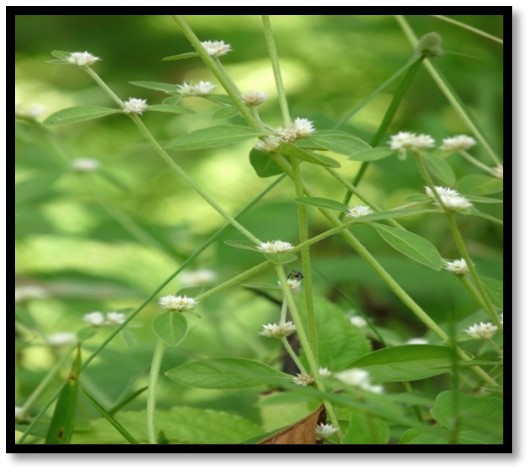
Fig no.11: Alternanthera sessilis
12. Hygrophila spinosa
This is aquatic medicinal plant explained in Ayurveda literature as Ikshura, Ikshughanda. Belongs to the family Acanthaceae. The whole plant contains terpenoids, fattyacids, minerals, phytosterols, vitamins, glycosides, alkaloids, proanthocyanins, mucilage, enzyme, carbohydrates, polyphenols, flavonoids. The screening method was performed on Wister albino rats by Lipchitz method. Ethylene glycol (EG) was used to produce hyeroxaluria and urolithiasis. In rats it’s showing increased excretion of oxalate (hyeroxaluria) calcium and serum uric acid then decreased excretion of magnesium. After administration of methonlic extract can decrease the calcium, uric acid and oxalate and increases mg excretion. Kidney forming agents can be decreased by methonlic extract. Hyperoxaluria which in turn causes increased lipid peroxidation and kidney tissue damage occurs. Calcium oxalate crystals deposition lead to kidney stones can be decreased by methonlic extract of H.spinosa. this plant is traditionally used in variety of diseases are Rheumatism, skin diseases, body pain, leucorrhoea, Gall stones, diarrhea, dysentery, urinogenital disorders, gastrointestinal ailments.[15]
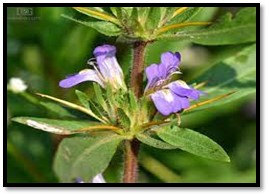
Fig no.12: Hygrophila spinosa
13. Nymphaea pubescens
It is a semi aquatic species of water lily. Which belongs to the family Nmphaeaceae. The water lilies are medicinal plants contains more activities like anodynic, Astringent, Cardio tonic, sedative, analgesic anti- inflammatory properties. N.pubenscens is known as pink water lily. Same genus but different species are there such as Nymphae alba, N.nouchali (blue water lily) N.odorata(fragrant water lily), N.rubra, N.lotus, N.tetragona(pygmy water lily), N.pubenscens rich in phytoconstituents are reported as Catechin, myricetin, ellagic acid, Gallic acid, rutin, vanillic acid, rosmarinicacid, quercetin, ascorbic acid and p_coumaric acid. Water lily is a national plant of Bangladesh. Root stock is used for urinary troubles, nephritis, urinary ailments and hemorrhoids. Bitters produce a diuretic effect and also regulate the secretion of the pancreatic hormones (insulin and glucagon).The whole plant is used as diuretic, particularly Rhizome, stem and roots infusion are previously owned as emollient, diuretic and blennorrhagia and diseases of urinary tract.[16]
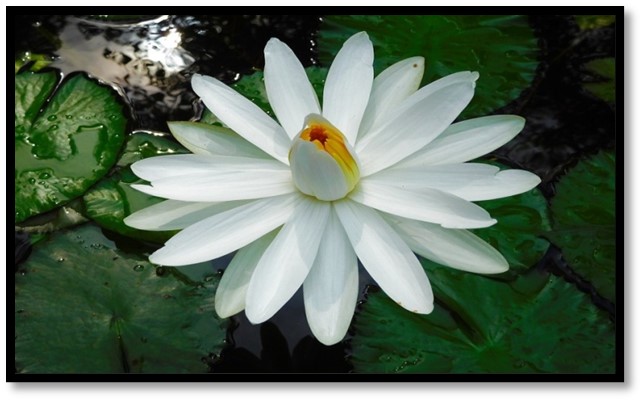
Fig no.13: Nymphaea pubescens


 G venkata Karthik Kumar Reddy * 1
G venkata Karthik Kumar Reddy * 1
 Shravya 2
Shravya 2
 Sinchana urs K N 3
Sinchana urs K N 3
 Sneha R V 4
Sneha R V 4
 Sneha Binu 5
Sneha Binu 5
 Sonam Choedon 6
Sonam Choedon 6












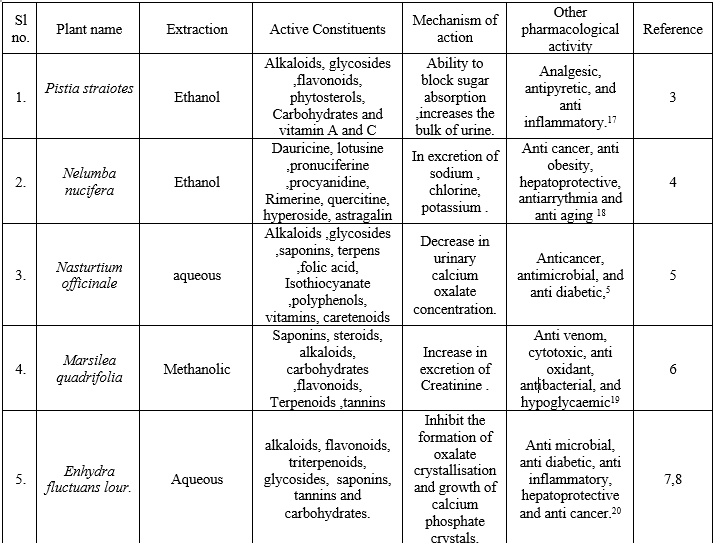

 10.5281/zenodo.13137274
10.5281/zenodo.13137274